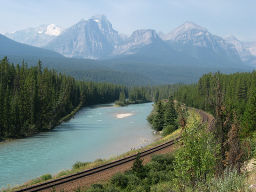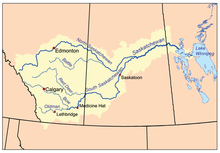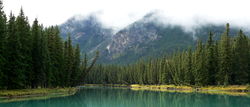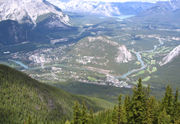Bow River
| Bow River | |
| River | |
 |
|
| Country | |
|---|---|
| Province | |
| Source | Bow Glacier |
| - elevation | 1,960 m (6,430 ft) |
| Mouth | South Saskatchewan River |
| - elevation | 700 m (2,297 ft) |
| Length | 587 km (365 mi) |
| Basin | 26,200 km² (10,116 sq mi) |
| Discharge | |
| - average | 129 m3/s (4,556 cu ft/s) |
 Map of the Bow River
|
|
The Bow River is a river in the Canadian province of Alberta. It is a tributary of the South Saskatchewan River, and is considered the headwater of the Nelson River.
The name "Bow" refers to the reeds that grew along its banks and which were used by the local First Nations peoples to make bows; the Peigan name for the river is "Makhabn", meaning "river where bow reeds grow".[1]
Contents |
Course

The river's source is from the Bow Glacier, which is part of the Wapta Icefield. The outflow from this source flows into Bow Lake in the Canadian Rockies. It flows south to the village of Lake Louise then turns east and flows through the town of Banff then through Canmore. The Ghost Lake reservoir is formed upstream from the town of Cochrane. The Bow then flows eastward to the city of Calgary; it continues on to form the South Saskatchewan River when the Bow joins with the Oldman River near Grassy Lake in southern Alberta. Its waters are further shed in the Hudson Bay through the Saskatchewan River, Lake Winnipeg and Nelson River.
Communities located on the Bow include Lake Louise, Banff, Canmore, Cochrane, Calgary, Arrowwood.
Bow River has a total length of 587 km (365 mi) and a drainage area of 26,200 km2 (10,116 sq mi).[2]
Conservation and development
This river is an important source of drinking water, water for irrigation and hydroelectric power. It also provides habitat for wildlife and opportunities for recreation such as fishing and boating. The Bow Falls are located on the river course, near Banff. The Bow Valley Provincial Park was established in the Bow Valley and is a part of the Kananaskis park system. The river is on the right of the 8th to 14th holes of the Banff Springs Hotel golf course.
Recreation

The Bow River provides many opportunities for boating and fishing. Both fly fishermen and spinner fishermen share the river in all four seasons of the year. Serious anglers from all over the world visit the Bow River for its thriving population of brown trout and rainbow trout. The Bow River holds a resident population of rainbow and brown trout that has one of the best growth rates to be found on any river system in the world today. A trout that is 4 to 5 years old will be around 21 inches in length and the Bow River holds many fish that are this size or larger. This is precisely why many fishermen from all over the world choose the Bow River to fish year after year. Mainly the river is fished south of the city of Calgary, past where the water treatment sites dump into the river, for that is where the nutrients are higher.
Outdoor adventurers use primarily three types of boats to enjoy the river, the inflatable boat, the Jon boat and the canoe. There are several spots located on the river to launch your watercraft which include Graves Landing, Highway 22X Bridge, Policeman’s Flats and McKinnon Flats.
The Bow River pathway, is developed on both banks of the river throughout the city of Calgary and is used for cycling, hiking, jogging, as well as rollerblading and skateboarding.
Tributaries
|
|
Many lakes, glacial and artificial are found in the Bow Valley: Bow Lake, Hector Lake, Vermilion Lakes, Gap Lake, Lac des Arcs and Ghost Lake on the upper course, and a few man-made reservoirs along the lower course.
Further reading
- Christopher Armstrong, Matthew Evenden, and H.V. Nelles. The River Returns: An Environmental History of the Bow (Toronto: McGill-Queen's University Press, 2009)
Photo gallery
 Bow Glacier |
 Bow River originates in Bow Lake. |
 Vermilion Lakes formed along the Bow River |
 Bow Valley with town of Banff |
|
Lac des Arcs formed along Bow River |
 Hoodoos above the Bow River. |
Ghost Lake in Bow Valley |
Crossing Bowness |
|
through Edworthy Park in Calgary |
 Crowchild Trail crossing the river in Calgary, downtown in background |
Bow River with Calgary Zoo |
References
- ↑ Bow Riverkeeper article about the river.
- ↑ Atlas of Canada - Rivers in Canada
External links
|
|||||||||||||||||||
